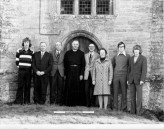Hunting and Coursing
This very old account of how to hunt and course was found in a collection of ringing papers. The author is unknown. I'm sure you will enjoy the slightly old fashioned language, but more than that I hope that you find that it explains these skills in a way that you can understand.
An Explanation of "Hunting"
Make sure that the terms "hunt" and "course" are thoroughly understood in order that practice may the quicker enable the learner to use them.
 Hunting is the act of "seeing" the bell which pulls after you, and must be first done when leading at backstroke (in Grandsire), even though you may know which bell is going to lead. Therefore, when the correct back-stroke leading positioin has been establisned - and this, for those who have not been taught, is when the hands of the Tenor man loose the sally - a quick glance should be taken at the bell following in 2nds. It cannot be too strongly emphasised how important it is that this first step of "hunting" should be understood and practiced. The bell that is going to lead is now known and the act of pulling after it is infinitely less important than that of "seeing" once again, who follows you this time at handstroke. By learning the bells that are going to be pulled after AND SEEING THEM PULL AFTER YOU will quickly enable the ringer to see which bell is pulling after him, regardless of the order in which they are met.
Hunting is the act of "seeing" the bell which pulls after you, and must be first done when leading at backstroke (in Grandsire), even though you may know which bell is going to lead. Therefore, when the correct back-stroke leading positioin has been establisned - and this, for those who have not been taught, is when the hands of the Tenor man loose the sally - a quick glance should be taken at the bell following in 2nds. It cannot be too strongly emphasised how important it is that this first step of "hunting" should be understood and practiced. The bell that is going to lead is now known and the act of pulling after it is infinitely less important than that of "seeing" once again, who follows you this time at handstroke. By learning the bells that are going to be pulled after AND SEEING THEM PULL AFTER YOU will quickly enable the ringer to see which bell is pulling after him, regardless of the order in which they are met.
An Explanation of "Coursing"
To learn to "course", each ringer should establish which bell will be the "course bell" of the bell he will be ringing in the Plain Course.
For the ringer of No.1 (the treble) the bell struck at backstroke at the end of three "whole pulls" is always the "course bell" in Grandsire Triples. Many have found it helpful to relate the whole pulls, ie handstroke and backstroke, to the positions reached by them: thus, the first whole pull is 2nds and 3rds, the next 4ths and 5ths and the last 6ths and 7ths. "Coursing" begins at the same time that the "course bell" is being struck, and the act of striking the "course bell" is infinitely less important than "seeing" who the course bell is striking, because this is the first bell struck by you in "coursing".
It is important to remember that the ringer of your "course bell" must "look" at the bell he is pulling after, and there-fore the eyes of the ringer of your "course bell" will always give you the informatioin you seek ie. the bell you yourself strike after in the succeeding row. Even if you fail to get the information from his eyes it is a MUST that you realise that only one bell separates you and your "course bell" all the way from "behind" down to lead, and by making the necessary adjustment for that one bell, you cannot be very far wrong. As the ringer of your "course bell" looks to the tenor to adjust his lead at handstroke, ie.as the tenor sally comes in sight from backstroke, you prepare to strike him at backstroke and lead next handstroke yourself.
As I said, I don't know where this account came from, but perhaps it was written by one of these ringers at Seavington St Mary photographed in 1970 or even in 1906.
